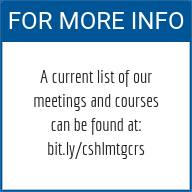Meet Tatiana Moiseeva of the University of Pittsburgh. The Russian national is a postdoctoral associate in Dr. Christopher Bakkenist’s lab. She returned to campus for her first CSHL course: Scientific Writing Retreat.
What are your research interests? What are you working on?
I study how human cells initiate the replication of their DNA and how they suppress the majority of the available replication origins that should only be used in the event of stress. Certain drugs that are currently in clinical trials can induce excessive replication initiation and make cells more prone to toxic DNA damage.
How did you decide to make this the focus of your research?
I have always been interested in basic science questions. The Bakkenist lab focuses on using certain kinase inhibitors to sensitize cancer cells to ionizing radiation, and we found an unexpected effect of a drug that was supposed to be inert in the absence of DNA damage. My natural curiosity took over and I had to figure out what happens exactly, and it turned out that I can use this drug to answer some basic science questions, so I couldn’t resist.
How did your scientific journey begin?
I completed my undergraduate and graduate degrees in St. Petersburg, Russia. I had amazing professors in the Polytechnical University who inspired me, encouraged discussion, critical thinking, taught me the importance of constant self-education, and really shaped my scientific mind. Doing research in Russia was not easy but they, by example, showed me that nothing is impossible if you put your mind to it. I have switched a few research topics since then, but I think my education is what defined my scientific path.
Was there something specific about the Scientific Writing Retreat course that drew you to apply?
Scientific writing is a critical part of working in academia. To date, I have written multiple manuscripts and grant proposals that I asked my PIs to look over. They always provided feedback but they weren’t always able explain why I should write something in a certain way. My goal in attending this course is to become more independent in my writing and improve this valuable skill for future work as an independent researcher.
What and/or how will you apply what you've learned from the course to your work?
Ask several people to read your text before submitting it. Getting feedback, even from non-experts, can help a lot.
What is your key takeaway from the course?
For any piece of scientific writing, proper structure is key. Whether it is a seven-figure paper or three-sentence abstract, the order of the messages is what matters the most.
How many CSHL courses have you attended? How about meetings at CSHL?
This is my first course but I am very curious about the Workshop on Leadership in Bioscience. I attended the Cell Cycle meeting in 2012 and DNA Replication meetings in 2015 and 2017. I am planning to attend the 2019 Eukaryotic DNA Replication & Genome Maintenance meeting.
If someone curious in attending this course asked you for feedback or advice on it, what would you tell him/her?
This course is very useful, informative, and intensive. Before coming to the retreat, think about the general and specific writing problems you are having because the time at the retreat is very tight. Anything can be solved, you will see the progress immediately. Also, the course is always the week before Thanksgiving - be ready for the snow!
What do you like most about your time at CSHL?
A chance to meet new people from very different backgrounds (that we don’t really get at scientific conferences), learn about their experiences and make new friends. Also, very good dinners.
Thank you to Tatiana for being this week's featured visitor. To meet other featured scientists - and discover the wide range of science that takes part in a CSHL meeting or course - go here.









